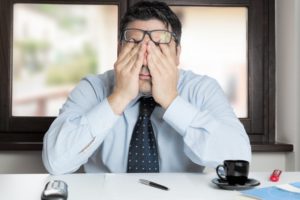 Over 22 million Americans are currently living with sleep apnea. If you discover that you, too, are suffering from this condition, how can a local sleep dentist help you recover? As you continue reading, you’ll learn what sleep apnea is, what symptoms to be on the lookout for and how you can get the rest you desperately need.
Over 22 million Americans are currently living with sleep apnea. If you discover that you, too, are suffering from this condition, how can a local sleep dentist help you recover? As you continue reading, you’ll learn what sleep apnea is, what symptoms to be on the lookout for and how you can get the rest you desperately need.
Sleep Apnea Explained
If you’ve been told that you snore loudly and make gasping sounds while slumbering, then there is a chance that you have sleep apnea, which refers to frequent stoppages in breathing at night. These interruptions, which can last up to 10 seconds, trigger your brain to send distress messages via your nervous system that stir you. For many people, this cycle can repeat hundreds of times throughout the night, leaving them feeling sleep deprived the next day. There are other warning signs to be on the lookout for as well.
The Common Symptoms of Sleep Apnea
Before seeking help for sleep apnea, you need to know what the common indicators are. If you notice any of the following symptoms, you should bring it to your doctor’s attention:
- Bouts of depression
- Morning headaches
- Daytime drowsiness
- Frequent mood swings
- Inability to concentrate
- Morning throat soreness
In addition to these lifestyle challenges, untreated sleep apnea can also leave you more susceptible to hypertension, diabetes, stroke and heart disease. If you’re diagnosed with the condition, your local sleep dentist can help you recover.
How Sleep Apnea Can be Treated
The typical means of treating sleep apnea is with a CPAP machine, which involves wearing a nasal mask while you sleep. While it’s a highly effective way of treating sleep apnea, many people find this method to be rather cumbersome, noisy and uncomfortable. There’s no need to worry, though, because there is another treatment alternative that soundly addresses sleep apnea: an oral sleep appliance.
The most common form of the condition is obstructive sleep apnea (OSA), which involves a partial or full blockage of the airway that triggers breath stoppages. A custom-designed oral appliance provides a convenient solution. The small apparatus is easy to transport, clean and store. And better yet, it provides a quiet and comfortable solution for your sleep interruptions.
Here are two common types:
- Mandibular Repositioning Device – Helps to move your jaw forward and slightly down to allow for better airflow while you sleep.
- Tongue Retaining Device – Focuses on securing the tongue so it won’t fall to the back of the mouth to block the throat.
Getting Started
Once you’ve undergone a sleep test and received a diagnosis, which can take up to 10 hours to complete, you can move forward with receiving the expert care you need from your local sleep dentist, so you can get adequate rest and function at your absolute best.
About the Author
Dr. Marc Thomas is a graduate of the University of the Pacific and current member of the American Academy of General Dentistry. As a professional who is committed to excellence, he has taken numerous hours of continuing education, which allows him to provide the comprehensive care that his patients need. A versatile dentist, Dr. Thomas effectively treats sleep apnea at Vista Dental Care, and he can be reached for more information through his website.
